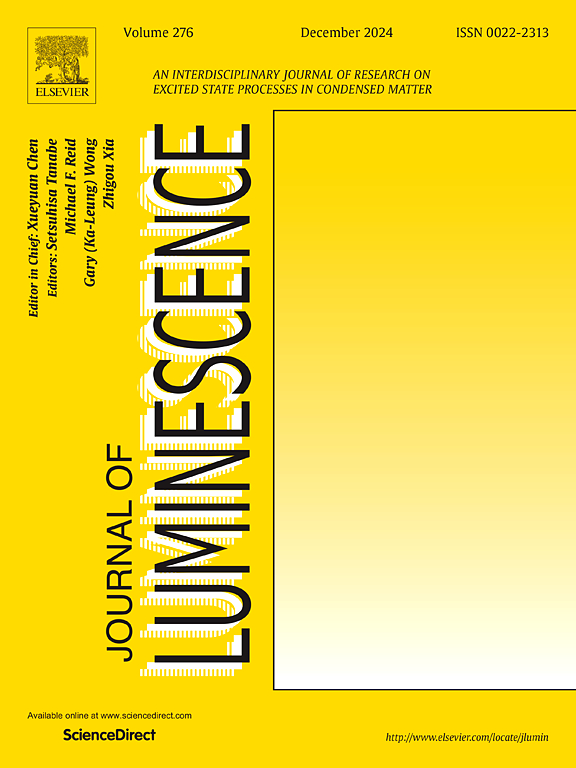Trypan blue dyed TGS crystal: Morphological, optical, thermal, mechanical, and ferroelectric properties
IF 3.3
3区 物理与天体物理
Q2 OPTICS
引用次数: 0
Abstract
Tri-glycine sulfate (TGS) single crystals were synthesized using the slow evaporation method, with samples prepared both undoped and doped with 0.1 mol% trypan blue (TB) dye. The external morphology of the crystals, both doped and undoped, was analyzed using the Bravais–Friedel–Donnay–Harker (B–F–D–H) model. Structural characteristics were examined through Fourier Transform Infrared (FTIR) spectroscopy and powder X-ray diffraction (XRD). UV–Vis–NIR spectral analysis revealed an optical transparency of approximately 65 % for both crystal types, with band gap energies of 5.20 eV for undoped TGS and 5.02 eV for TB-doped TGS. The inclusion of TB dye enhanced the mechanical hardness, thermal stability, and melting point of the TGS crystals. Piezoelectric studies showed a significant increase in the piezoelectric coefficient (d22) from 53 pC/N in undoped TGS to 82 pC/N in TB-doped TGS. Precise remnant polarization was calculated for the doped crystal using the “Remnant Hysteresis Task,” highlighting minimal contributions from non-switchable factors. Comparative investigations of thermal, ferroelectric, optical, and mechanical properties demonstrate that TB-dyed TGS crystals outperform their undoped counterparts, suggesting their potential for advanced ferroelectric and electro-optic applications.
台盼蓝染色TGS晶体:形态、光学、热、机械和铁电性质
采用慢蒸发法制备了三甘氨酸硫酸酯(TGS)单晶,样品分别掺杂和未掺杂0.1 mol%的台盼蓝(TB)染料。使用Bravais-Friedel-Donnay-Harker (B-F-D-H)模型分析掺杂和未掺杂晶体的外部形貌。通过傅里叶变换红外光谱(FTIR)和粉末x射线衍射(XRD)分析了其结构特征。紫外-可见-近红外光谱分析显示,两种晶体的光学透明度约为65%,未掺杂TGS的带隙能为5.20 eV,掺杂tb的带隙能为5.02 eV。TB染料的加入提高了TGS晶体的机械硬度、热稳定性和熔点。压电研究表明,TGS的压电系数(d22)从未掺杂TGS的53 pC/N显著增加到掺tb TGS的82 pC/N。使用“残余滞后任务”计算了掺杂晶体的精确残余极化,突出了不可切换因素的最小贡献。热、铁电、光学和机械性能的对比研究表明,tb染色的TGS晶体优于未掺杂的TGS晶体,这表明它们具有先进铁电和电光应用的潜力。
本文章由计算机程序翻译,如有差异,请以英文原文为准。
求助全文
约1分钟内获得全文
求助全文
来源期刊

Journal of Luminescence
物理-光学
CiteScore
6.70
自引率
13.90%
发文量
850
审稿时长
3.8 months
期刊介绍:
The purpose of the Journal of Luminescence is to provide a means of communication between scientists in different disciplines who share a common interest in the electronic excited states of molecular, ionic and covalent systems, whether crystalline, amorphous, or liquid.
We invite original papers and reviews on such subjects as: exciton and polariton dynamics, dynamics of localized excited states, energy and charge transport in ordered and disordered systems, radiative and non-radiative recombination, relaxation processes, vibronic interactions in electronic excited states, photochemistry in condensed systems, excited state resonance, double resonance, spin dynamics, selective excitation spectroscopy, hole burning, coherent processes in excited states, (e.g. coherent optical transients, photon echoes, transient gratings), multiphoton processes, optical bistability, photochromism, and new techniques for the study of excited states. This list is not intended to be exhaustive. Papers in the traditional areas of optical spectroscopy (absorption, MCD, luminescence, Raman scattering) are welcome. Papers on applications (phosphors, scintillators, electro- and cathodo-luminescence, radiography, bioimaging, solar energy, energy conversion, etc.) are also welcome if they present results of scientific, rather than only technological interest. However, papers containing purely theoretical results, not related to phenomena in the excited states, as well as papers using luminescence spectroscopy to perform routine analytical chemistry or biochemistry procedures, are outside the scope of the journal. Some exceptions will be possible at the discretion of the editors.
 求助内容:
求助内容: 应助结果提醒方式:
应助结果提醒方式:


